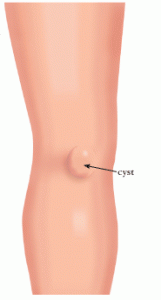 A Baker’s cyst, also called a popliteal cyst, is a fluid-filled lump behind the knee. It is named after William Morrant Baker, the doctor who first described it. The cyst occurs when the popliteal bursa, a soft pouch behind the knee, accumulates excess fluid and expands. It may feel like a water-filled balloon.
A Baker’s cyst, also called a popliteal cyst, is a fluid-filled lump behind the knee. It is named after William Morrant Baker, the doctor who first described it. The cyst occurs when the popliteal bursa, a soft pouch behind the knee, accumulates excess fluid and expands. It may feel like a water-filled balloon.
The fluid in a Baker’s cyst is synovial fluid, which normally lubricates the joint. Excess fluid can build up after an injury such as a tear of the meniscal cartilage in the knee. These cysts are also associated with knee arthritis.
Symptoms may include stiffness, pain, swelling, or a decrease in range of motion. A cyst that ruptures may also cause bruising on the back of the knee and calf. Sometimes a blood clot can be confused with a ruptured Baker’s cyst, but in the case of a blood clot, immediate treatment is required. If your calf is red and swollen, you should seek medical attention.
Baker’s cysts may go away without treatment, but large and painful cysts are usually treated. If you have a Baker’s cyst, a physical therapist can teach you range of motion and strengthening exercises to reduce symptoms and maintain knee function. Your therapist may also apply ice or a compression bandage to reduce swelling. Your doctor may also reduce swelling with a corticosteroid injection or by draining the fluid from the cyst. If the cyst is caused by torn cartilage or arthritis, surgery may be recommended.